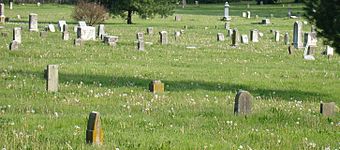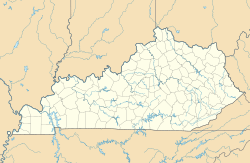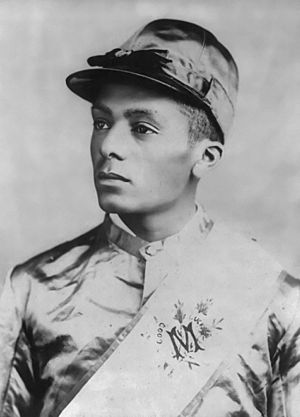African Cemetery No. 2 (Lexington, Kentucky) facts for kids
Quick facts for kids |
|
|
African Cemetery No. 2
|
|

African Cemetery No. 2
|
|
| Location | Lexington, Kentucky |
|---|---|
| Area | 7.7 acres (3.1 ha) |
| NRHP reference No. | 04000245 |
| Added to NRHP | March 31, 2004 |
African Cemetery No. 2 is a very old and important burial ground in Lexington, Kentucky, United States. It is also known as The Cemetery of the Union Benevolent Society No. 2. This cemetery holds the stories of many people who helped shape Kentucky's history.
Contents
Founding and History
People started burying loved ones on this land as early as the 1820s. Later, in 1869, a group called the Colored Peoples Union Benevolent Society No. 2 bought the property. They wanted to use it as a proper cemetery for their community. The last burials happened here in 1974.
In 1889, about 300 bodies were moved to African Cemetery No. 2. They came from another cemetery on Limestone Street. This big move was overseen by C. O. H. Thomas.
The city government of Lexington took over the cemetery in 1973. Then, in 1979, a new group was formed. It was called African Cemetery No. 2, Incorporated. Their goal was to protect and save the cemetery.
In June 2003, a special marker was placed at the site. This marker, called a Kentucky Historical Highway Marker, tells people about the cemetery's history. The cemetery was officially added to the National Register of Historic Places on March 31, 2004. This means it's a very important historical site.
Who is Buried Here?
This 7.7-acre (3.1 ha) cemetery is home to over 5,000 graves. About 1,200 of these graves have been identified. However, fewer than 600 still have clear markers or headstones.
Honoring Veterans
Many brave military veterans are buried here, totaling 148. A large number, 112, were U.S. Colored Troops who fought in the American Civil War. About 80 of these soldiers trained at nearby Camp Nelson. Camp Nelson was a major supply and recruitment center for the Union army.
Kentucky had almost 24,000 U.S. Colored Troops, and 10,000 of them trained at Camp Nelson. Besides Kentucky, Civil War veterans from New York, Massachusetts, Arkansas, and Tennessee are also buried here.
Since 2005, a special event called Juneteenth Jubilee is held every year. It honors the Civil War veterans buried in the cemetery. During this event, an American flag is placed on each veteran's grave. Every name is also read aloud.
Other veterans buried here include 12 from the Buffalo Soldiers/Spanish-American War. There are also 18 veterans from World War I and 4 from World War II.
One notable soldier was Clarence Espy. He served with the 369th Infantry. This regiment became famous as the "Harlem Hell Fighters". Espy was from Lexington and received the Croix de Guerre. This is France's highest military honor.
Important People
R. C. O. Benjamin was a journalist and an attorney. He died on October 2, 1900, during an argument about voting rights for African Americans. In 1910, a monument was placed at his grave.
Horse Racing Legends
Over 150 graves belong to people who worked with horses. These include trainers, jockeys, foremen, stablehands, and grooms. Their birthdates range from 1842 to 1897, and their death dates from 1890 to 1932. This shows how important African Americans were in the horse and racing industry back then. Some people born before 1866 were likely born enslaved.
Thoroughbred Racing Hall of Fame jockey, Isaac Burns Murphy, was first buried in African Cemetery No. 2. Murphy was born in 1861. He was the first jockey to win three Kentucky Derby races. He passed away on February 12, 1896, from pneumonia.
Later, in 1967, his remains were moved to the Man o' War gravesite. Then, in 1987, they were moved again to the Kentucky Horse Park.
The International Museum of the Horse is at the Kentucky Horse Park. They are working with cemetery volunteers on a project. It's called the Chronicle of African-Americans in the Horse Industry. This is an online learning tool. It shares the stories of African Americans and their role in the horse industry. The museum also has a permanent exhibit. It's called Black Horsemen of the Kentucky Turf. This exhibit celebrates the important contributions of African Americans to Kentucky's horse industry. Some of the people featured in this exhibit are buried at African Cemetery No. 2.
Restoring the Cemetery
On April 4, 2002, volunteers helped search and map the cemetery grounds. They studied the physical layout of the area.
Experts have also studied how to best preserve the cemetery's gravestones. A paper published in Building and Environment discussed this topic. It looked at how to combine scientific knowledge of decay with ways to protect historical sites. It also considered the needs of the people involved.
See Also




